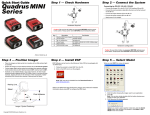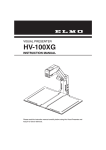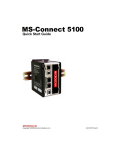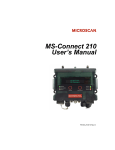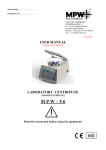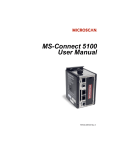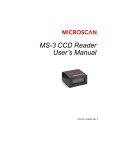Download Microscan EZ Match Imager User manual
Transcript
Quick Start Guide EZ Match Imager Step 1 — Check Hardware Step 2 — Connect the System Connecting by RS-232 / RS-422 / RS-485 1 2 Connect the imager (1) to the IB-131/IC-332 interface (2) and (3). Connect the host cable (6) to the host and to the host port on the IB-131 (3). Connect the object detector (5) to the IB-131 (3). Connect the power supply (4) to the IB-131 (3). Apply power to the imager. 3 Host Network Scanner 6 • • • • • 1 2 5 3 Scanner 6 Host Hardware Required Network 4 Caution: Be sure that all cables are connected BEFORE applying power to the system. Always power down BEFORE disconnecting any cables. 4 P/N 83-210051 Rev B Step 3 — Position the Imager • Place the imager in an area with as little ambient light as possible. • Place a black surface behind the area in which test tubes, caps, or symbols will be inspected by the imager. The black background provides the contrast necessary for the imager to detect the presence or absence of objects in its field of view. • Position the imager at a focal distance between 2 and 6 inches from a sample tube, cap, or symbol. • Position the imager relative to the object to avoid the glare of direct (specular) reflection. Important: Avoid excessive skew or pitch. Maximum skew is ±30°; maximum pitch is ±30°. ml 10 8 6 4 2 Place a black background behind the area where tubes, caps, or symbols will be inspected by the imager. This provides the contrast necessary for the imager to detect the presence or absence of objects in the field of view. EZ Match Imager and Object in Field of View • Objects can be rotated at any angle; however, for best results, objects should be aligned with the FOV (field of view). Note: For accuracy of testing and performance, Microscan recommends using a mounting arm adapter kit. Contact your Microscan sales manager for details about mounting arm adapter kits and other accessories. Copyright ©2015 Microscan Systems, Inc. Item 1 2 3 4 5 6 Description 5 Part Number EZ Match Imager (B&W or Color) FIS-0004-100XG IC-332 Adapter FIS-0001-0035G IB-131 Interface Box 99-400018-01 Power Supply 97-100004-15 (90-264 VAC, 24 VDC) Object Detector (optional) 99-000017-01 Host Cable 61-300026-01 Step 4 — Install ESP ESP Software can be found on the Microscan Tools CD that is packaged with the EZ Match. 1. Follow the prompts to install ESP from the CD. 2. Click on the ESP icon to run the program. Note: ESP can also be installed from the Download Center at www.microscan.com. ESP System Requirements • 166 MHz Pentium processor (recommended) • Windows Vista, XP, or 2000 operating system • Internet Explorer 5.0 or higher • 64 MB minimum RAM • 40 MB minimum disk space Hardware Configuration Caution: Be sure that all cables are connected BEFORE applying power to the system. Always power down BEFORE disconnecting any cables. Step 5 — Select Model The following menu will appear when you start ESP: Important: An EZ Match Imager must be connected to the host computer for its corresponding icon (shown at left) to appear on the model menu. The icon will always be present in subsequent ESP sessions, even when the EZ Match unit is not physically connected. 1. Click the button showing the EZ Match Imager. 2. Click OK. Note: You can also double-click the EZ Match button to make your selection. 3. Click Yes when this dialog appears: Refer to the EZ Match Imager User Manual for detailed information about using ESP to configure the EZ Match. Note: If you need to select another model later, click the Switch Model button near the top of the screen or use Model > New Model in the menu toolbar. Step 6 — Select Protocol and Connect • Choose the connection protocol you are using and click Connect. Step 7 — Locate the Object Locate the Object by ESP • In ESP’s EZ Mode, click the Locate button to enable the blue target pattern. The object in the field of view will appear in the video view beneath the Locate and Calibrate buttons, and you will see the blue target pattern projected from the front of the imager. • Center the target pattern on the object. At 2 to 3 inches, the pattern resembles an X. At 3 to 6 inches, the pattern resembles a V. Important: The entire object of interest (tube, cap, or symbol) should fall within the field of view (FOV) of the imager. The field of view is what appears in ESP’s Locate/Calibrate window in EZ Mode. • Click the Stop button to end the Locate function. • Once you select your communications mode, follow the simple prompts to establish your connection. • When you are connected, you will see the green connection indicator in the status bar at the bottom right of your screen. RS-232: Locate the Object by EZ Button If you are not connected to a host computer, the EZ Button allows you to locate an object in the imager’s field of view. • Hold down the EZ Button for about one second and release when you hear one short beep. The amber 20% LED will illuminate, and you will see the blue target pattern projected from the front of the imager. • Center the target pattern on the object. USB: Step 9 — Test Read Rate Read Rate indicates the number of tube/cap detections or successful decodes per second achieved by the imager. Note: To end all EZ Button functions, press the EZ Button once and quickly release. Step 10 — Configure the Imager To make setup changes to the EZ Match Imager, click the App Mode button. Test Read Rate by EZ Button 1. To start the Read Rate test, hold down the EZ Button about three seconds until you hear three short beeps. The 20%, 40%, and 60% LEDs will illuminate. While the object is being inspected, the Read Rate LEDs will indicate the read rate percentage on the back of the unit. 2. To end the Read Rate test, press the EZ Button and quickly release. Test Read Rate by ESP 1. Click the Test button to start the Read Rate test and Stop to end it. The following modes are accessible by clicking the buttons in the first row of App Mode icons: • • • • • If a tube or cap has been successfully detected, or a symbol has been successfully decoded, the object’s data and related features will be presented in the field below the image display window. Also, while the object is being inspected, the Read Rate LEDs will indicate the Read Rate percentage on the back of the unit. 2. To end the test, click the Stop button. Note: Read Rate can also be tested using the Read Rate interface in Utilities. • • Test Read Rate by Serial Command • You can also start a test with the <C> or <Cp> command and end it with the <J> command. • Copyright ©2015 Microscan Systems, Inc. Click the EZ Mode button to return to EZ Mode. Click the Autoconnect button to establish communication. Click the Send/Recv button to send or receive commands. Click the Switch Model button to open the model menu, or to return to a previous model. Click the EZ Match button to Test the imager and to configure Multi-Operation settings, tube/cap Library settings, and tube/cap detection Messages. Click the Parameters button to show the tabbed tree controls for Communication, Read Cycle, Symbologies, I/O Parameters, Symbol Quality, Matchcode, and Diagnostics. Click the Setup button to access a Camera Setup tree control and Video view, Evaluate image captures, Calibrate the imager, set the Window of Interest, fine-tune capture settings and processing settings in the IP Database, set up output filters and parse symbol data in Ordered Output and Output Format, and control multiple read cycle functions in Dynamic Setup. Click the Terminal button to display tube or cap detection data or decoded symbol data, and to send serial commands to the imager using text or macros. Click the Utilities button to test Read Rate, request or clear Counters, enable or disable the imager or send output pulses in Device Control, determine the Differences from Default in the current settings, add or remove master symbol data in Master Database, and verify or update the imager’s Firmware. For further details, see ESP Help in the dropdown Help menu. Step 8 — Calibrate EZ Match settings can be adjusted automatically for optimum tube/cap detection and symbol decoding performance by either the EZ Button or by ESP. During the calibration routine, the imager will flash its amber Read Rate percent LEDs and red illumination LEDs while searching camera settings and determining the best configuration for detecting tubes or caps, or for decoding symbol data. Upon successful completion of this routine, a green LED pattern will flash brightly and illuminate the object. If unsuccessful, the imager will emit 5 short beeps and stop searching. Calibrate by EZ Button 1. Hold down the EZ Button for about two seconds and release when you hear two short beeps. The 20% and 40% LEDs will illuminate. 2. The imager will search camera settings to determine the best configuration for detecting tubes or caps, or for decoding symbol data. Note: To end all EZ Button functions, press the EZ Button once and quickly release. Calibrate by ESP 1. Click the Calibrate button. 2. The imager will search camera settings to determine the best configuration for detecting tubes or caps, or for decoding symbol data. A successful calibration will display a green frame around the object, and the following message will appear: “Uploading all reader parameters.” After a moment the tube/cap data and/or symbol data will be presented in the field below the image display window. Calibrate by Serial Command Send <@CAL> from a terminal program to begin calibration. Step 11 — Save Configuration To make changes to a configuration setting: 1. Left click on the + to expand the desired tree. 2. Double click on the desired parameter and click once in the selection box to view options. 3. Place your cursor in the selection box, scroll down to the setting you want to change, and click once on the setting. 4. Left click on the open screen to complete your selection. 5. Right click on the open screen and select Save to Reader to implement the command in the imager. Saving Options • Send, No Save. Changes will be lost when power is re-applied to the imager. • Send and Save. This activates all changes in current memory and saves to the imager for power-on.


